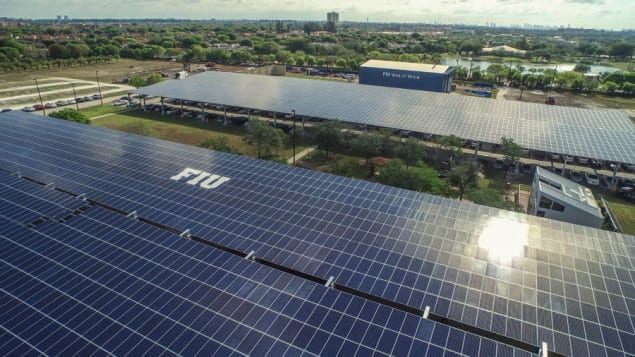Solar array powers the grid while research initiative will help further advance solar generation in Florida

FIU and Florida Power & Light Company (FPL) today unveiled a new commercial-scale solar installation at FIU’s College of Engineering and Computing – the only solar research facility of its kind that FPL has installed at a Florida university.
The 1.4-megawatt solar array is comprised of more than 4,400 solar panels on canopy-like structures that provide clean electricity to FPL’s grid and shade for about 400 parking spaces. The unique solar array incorporates a 24-foot by 12-foot FIU logo that is visible from high above.
Engineering faculty and students from the Energy, Power & Sustainability (EPS) program at FIU will use the installation to conduct important research that will help FPL advance solar energy in the state.
Through a five-year research grant, faculty and students are analyzing data from the on-site solar panels to understand the impacts of intermittent solar power on the electric grid in South Florida’s tropical climate. The researchers will also look at historic weather patterns and develop predictive models to forecast the reliability of solar power generation.
“This research project builds on our long-standing relationship with FPL,” said FIU President Mark B. Rosenberg. “We’re engaging in groundbreaking, problem-solving research to address the challenges of our region and beyond. Our students will get hands-on experience and see how the research they conduct in the lab will have an impact in the real world – gaining skills that will help them compete for high tech 21st century jobs. This solar power facility is a win-win for FIU, FPL, and our community.”
FPL is the state’s largest generator of solar energy and operates three utility-scale, or universal, solar plants in Florida. The company is constructing three new 74.5-megawatt solar energy centers that will cost-effectively triple its solar capacity by the end of 2016.
“We work hard every day to deliver our customers electricity that is among the cleanest and most reliable in the county for a price well below the national average,” said Eric Silagy, president and CEO of FPL. “Through this innovative partnership, we will continue to make our energy infrastructure even smarter. The faculty and students working on this project are contributing to our state’s energy future – a future that includes more solar power.”
FIU researchers are looking closely at Florida’s climate as part of their research.
“Solar power depends on the sun for fuel and with South Florida’s tropical weather conditions the amount of sun can vary greatly from one moment to the next,” said Arif Sarwat, a professor in the Department of Electrical and Computer Engineering who serves as director of the FIU and FPL Solar Research Facility and EPS. “In Florida, where sunshine can vary moment to moment, our team is researching how intermittent power generation impacts the grid with an eye toward a better understanding of how to best leverage solar power.”
For more than three decades, FPL and FIU have partnered on various projects. In addition to hundreds of FPL employees who are FIU alumni, the energy company runs an on-campus customer care training center where students answer calls from customers. FPL also donated an electric vehicle from its clean fleet to FIU’s College of Engineering and Computing to further research and test wireless charging technology.
Besides conducting research on wireless charging, EPS students also work at the FPL laboratories every week to conduct high-end experiments and research on batteries and access points.
“This project further demonstrates FIU’s commitment to working with FPL to help prepare our students for addressing society’s needs for renewable energy,” said Ranu Jung, interim dean of the College of Engineering and Computing. “Our faculty and students are engaged in research related to multiple facets of power generation, and this partnership will help strengthen their contributions to making solar energy viable and economical.”
For images and videos of the solar panel installation, please click here.






